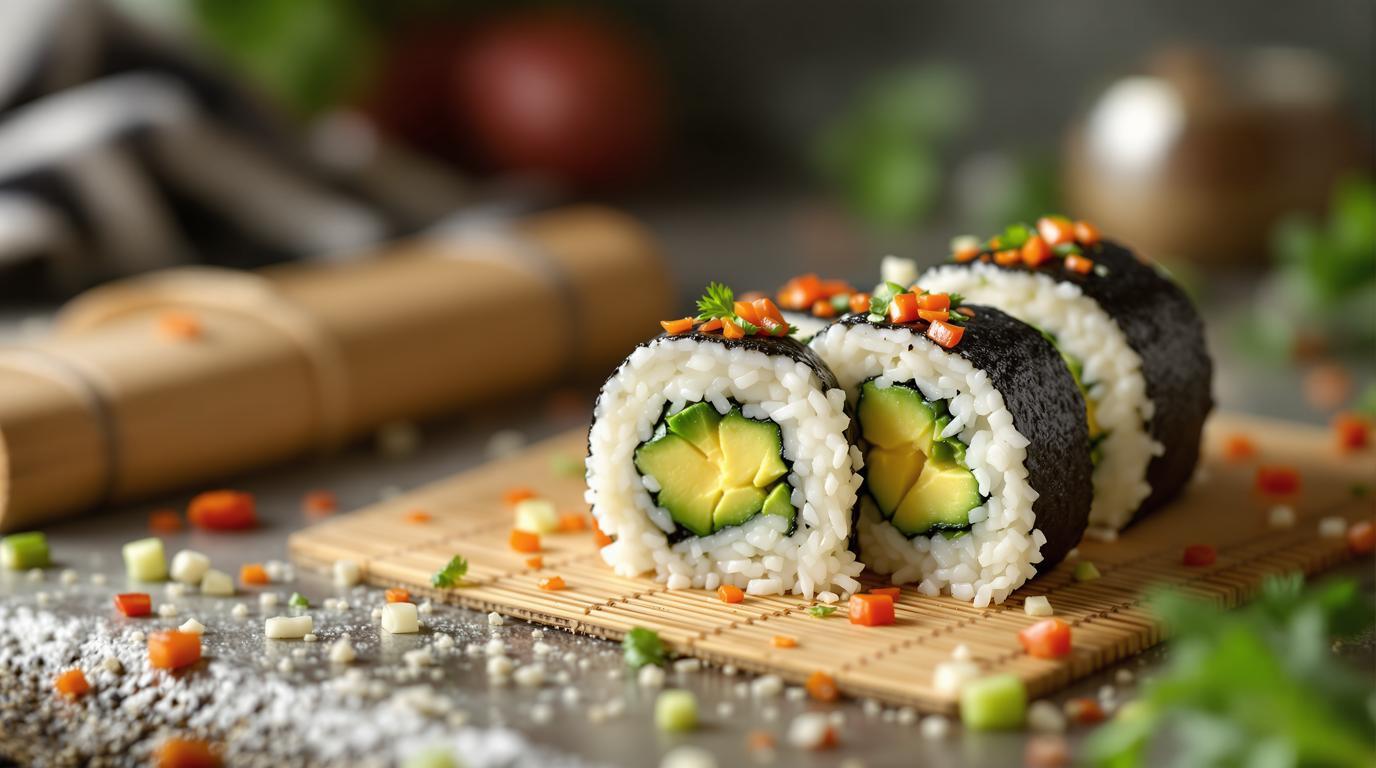The perfect sushi roll should be a balance of textures and flavors – crisp vegetables, creamy avocado, and perfectly seasoned rice. My journey with vegetarian sushi began years ago in a tiny Tokyo kitchen where my mentor, Chef Tanaka, showed me that the essence of great sushi isn’t fish, but rather the harmony of simple ingredients prepared with care. Summer rolls hold a special place in my heart because they showcase the season’s brightest produce while requiring minimal cooking – ideal for those sweltering days when turning on the stove feels like punishment.
The Art of Summer Sushi 🌿
Traditional Japanese makimono (rolled sushi) has evolved over centuries, but the principles remain unchanged: quality ingredients, proper rice preparation, and thoughtful assembly. While many associate sushi exclusively with seafood, vegetable rolls have deep roots in Japanese Buddhist traditions, where plant-based eating has been practiced for generations.
“When I was training in Kyoto,” I often tell my students, “I learned that the best vegetarian rolls celebrate seasonal vegetables rather than trying to imitate fish. The cucumber provides refreshing crunch, carrot adds sweetness and color, while avocado delivers that creamy richness that makes each bite satisfying.”
Essential Ingredients 🧾
For the sushi rice:
• 2 cups Japanese short-grain rice (400g)
• 2½ cups water (590ml)
• ½ cup rice vinegar (120ml)
• 2 tablespoons sugar
• 1 teaspoon salt
For the rolls:
• 6-8 nori sheets
• 1 large cucumber, julienned
• 1 medium carrot, julienned and briefly blanched
• 1 ripe avocado, sliced
• 1 tablespoon lemon juice
• Optional: Toasted sesame seeds
Chef’s Note: The rice is truly the foundation of exceptional sushi. Never substitute regular long-grain rice; it lacks the stickiness needed for proper rolls. I prefer Koshihikari variety for its perfect balance of stickiness and individual grain integrity.
The Perfect Sushi Rice 🍚
Begin by thoroughly rinsing your rice until the water runs clear – this removes excess starch that would make your rice too gummy. After cooking, the magic happens with the seasoning:
- Combine rice vinegar, sugar, and salt in a small saucepan and heat just until dissolved – never boil.
- Transfer cooked rice to a large wooden bowl (hangiri if you have one, though any non-metallic bowl works).
- Drizzle vinegar mixture over hot rice while using a slicing motion with a rice paddle to incorporate – don’t stir or mash!
- Fan the rice gently as you mix to create glossy, separate grains with a subtle sheen.
Allow the rice to cool to room temperature before rolling – warm rice will create soggy nori. This cooling process is where many home cooks rush, but patience yields perfectly textured rolls.
Rolling Technique 🔄
The key to beautiful rolls lies in gentle but confident handling:
- Place your bamboo mat (makisu) on a clean work surface, optionally covered with plastic wrap for easier cleaning.
- Position a nori sheet shiny-side down on the mat.
- With moistened hands, spread about ¾ cup of prepared rice evenly across the nori, leaving a 1½-inch strip exposed at the top edge.
- Arrange your vegetable fillings horizontally across the center of the rice.
- Lift the edge of the mat closest to you, tucking it over the fillings while applying gentle pressure.
- Continue rolling forward, applying even pressure to create a compact cylinder.
- When you reach the exposed nori edge, lightly moisten it with water to seal the roll.
Allow your completed roll to rest for 2-3 minutes before slicing with a sharp, wet knife. Clean the blade between cuts for pristine presentation.
Serving Suggestions 🍽️
While soy sauce and wasabi are traditional accompaniments, I like to offer a light citrus dressing alongside these summer rolls. For a complete meal, pair with a refreshing kombucha cocktail or consider ending with strawberry cheesecake bites for dessert.
If you’re entertaining, these rolls pair beautifully with caramelized pineapple from the grill, creating an impressive spread that celebrates summer’s bounty. For beverage pairings, consider a coconut water mai tai for a tropical complement.
The beauty of these summer rolls lies in their versatility. Don’t have avocado? Substitute thin slices of ripe mango. Missing carrots? Red bell pepper provides similar sweetness and crunch. The technique remains the same, but the flavors can evolve with your garden’s offerings or market finds.
What I cherish most about these vegetarian rolls is how they connect us to the mindfulness inherent in Japanese cuisine – the careful preparation, the seasonal ingredients, the balance of flavors. In our busy world, the act of rolling sushi becomes a meditation of sorts, forcing us to slow down and create something beautiful with our hands. That, perhaps more than any ingredient or technique, is the true secret to exceptional summer rolls.
